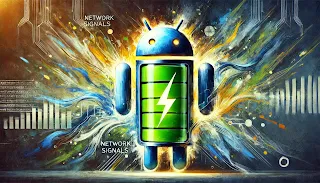Battery optimization in Android apps refers to designing and implementing features that minimize battery consumption while maintaining functionality and performance. It involves efficient use of resources like CPU, network, and location services, reducing background activity, and leveraging Android's power-saving features such as Doze Mode and Adaptive Battery.
Key techniques include:
- Scheduling background tasks efficiently with WorkManager or JobScheduler.
- Limiting network requests and caching data locally.
- Optimizing location tracking using the Fused Location Provider.
- Reducing UI overdraw and using lightweight animations.
- Managing WakeLocks responsibly to avoid unnecessary device wake-ups.
This helps improve user experience, prolongs battery life, and ensures compliance with Android's energy-saving policies.
To achieve effective battery optimization in Android apps, engineers need to focus on strategies that reduce energy consumption at the system, app, and user interaction levels. Below is a more detailed breakdown of actionable steps:
1. Background Tasks Management
Key Practices:
- Use WorkManager for deferrable and guaranteed background tasks, such as syncing or periodic data refresh. WorkManager adapts to constraints (e.g., only run tasks on Wi-Fi or during charging).
- Avoid using
ThreadorTimerfor scheduling tasks; instead, use Android's optimized task schedulers like AlarmManager, JobScheduler, or WorkManager. - For real-time background tasks:
- Use Foreground Services only when necessary, with proper notifications to keep users informed.
- Limit background work to the minimal level by offloading non-critical tasks to the server or executing them during idle times.
Example:
val workRequest = PeriodicWorkRequestBuilder<MyWorker>(15, TimeUnit.MINUTES)
.setConstraints(
Constraints.Builder()
.setRequiredNetworkType(NetworkType.CONNECTED)
.setRequiresCharging(true)
.build()
).build()
WorkManager.getInstance(context).enqueue(workRequest)
2. Efficient Network Operations
Network activities are one of the most power-consuming aspects of mobile apps.
How to Optimize:
- Batch network requests to minimize frequent power-ups of the radio hardware.
- Use Exponential Backoff Algorithms for retries to avoid unnecessary retries in case of network failures.
- Cache data locally using Room, SharedPreferences, or SQLite, so the app doesn’t need to fetch data repeatedly.
- Compress and optimize data payloads (e.g., using GZIP compression or sending only differential updates).
Example with Retrofit:
val okHttpClient = OkHttpClient.Builder()
.cache(Cache(File(context.cacheDir, "http_cache"), 10 * 1024 * 1024)) // 10MB cache
.addInterceptor { chain ->
val request = chain.request().newBuilder()
.header("Cache-Control", "max-age=3600") // 1-hour cache
.build()
chain.proceed(request)
}
.build()
val retrofit = Retrofit.Builder()
.client(okHttpClient)
.baseUrl(BASE_URL)
.addConverterFactory(GsonConverterFactory.create())
.build()
3. Location Optimization
Location services can drain a battery significantly if used inefficiently.
Best Practices:
- Use the FusedLocationProviderClient for location services.
- Request location updates only when necessary and specify appropriate intervals and accuracy.
- Implement Geofencing API for scenarios requiring location monitoring rather than continuous tracking.
Example:
val locationRequest = LocationRequest.create().apply {
interval = 10000 // 10 seconds
fastestInterval = 5000
priority = LocationRequest.PRIORITY_BALANCED_POWER_ACCURACY
}
fusedLocationClient.requestLocationUpdates(
locationRequest,
locationCallback,
Looper.getMainLooper()
)
4. Optimize UI Rendering
Rendering UI efficiently can reduce CPU and GPU workload.
Steps:
- Avoid overdraw (i.e., rendering the same pixel multiple times).
- Use the Show GPU Overdraw option in Developer Options to identify issues.
- Flatten nested layouts by using ConstraintLayout or Jetpack Compose.
- Recycle bitmaps or use Glide/Picasso for image loading and caching.
Compose Example to Avoid Overdraw:
@Composable
fun OptimizedUI() {
Surface(modifier = Modifier.fillMaxSize()) {
Text("Hello World", style = MaterialTheme.typography.h6)
}
}
5. Optimize Data and Storage Handling
Approaches:
- Minimize frequent I/O operations by using in-memory caching mechanisms like
LruCache. - Batch multiple database updates or writes into a single transaction to minimize disk activity.
Example:
database.runInTransaction {
dao.insert(data1)
dao.update(data2)
dao.delete(data3)
}
6. Use WakeLocks Judiciously
WakeLocks prevent the device from entering low-power idle mode, which can drain the battery.
Guidelines:
- Acquire WakeLocks only when necessary and release them immediately after use.
- Use PARTIAL_WAKE_LOCK if the CPU needs to stay active while the screen remains off.
Example:
val powerManager = context.getSystemService(Context.POWER_SERVICE) as PowerManager
val wakeLock = powerManager.newWakeLock(PowerManager.PARTIAL_WAKE_LOCK, "MyApp::MyWakeLock")
try {
wakeLock.acquire(10 * 60 * 1000L /* 10 minutes */)
// Perform task
} finally {
wakeLock.release()
}
7. Monitor Battery Usage
Android provides tools for profiling battery consumption.
Tools to Use:
- Battery Historian: Analyze battery-related events.
- Android Profiler in Android Studio: Monitor CPU, memory, network, and energy usage.
- adb shell dumpsys battery: Gather battery stats programmatically.
8. Manage Notifications
Frequent notifications can wake up the device unnecessarily.
Steps:
- Use Notification Channels to let users control notification importance.
- Consolidate multiple notifications into a single notification with a summary.
- Avoid unnecessary wake-ups by using low-priority notifications when the app is in the background.
Example:
val notificationManager =
context.getSystemService(Context.NOTIFICATION_SERVICE) as NotificationManager
val channel = NotificationChannel(
"low_priority",
"Low Priority Notifications",
NotificationManager.IMPORTANCE_LOW
)
notificationManager.createNotificationChannel(channel)
9. Leverage Modern APIs
- Use Doze Mode and App Standby optimizations:
- Ensure background tasks comply with Android Doze and Standby bucket restrictions.
- Adopt ForegroundService API and reduce background execution on devices running Android 8.0+.
Example:
override fun onStartCommand(intent: Intent?, flags: Int, startId: Int): Int {
startForeground(NOTIFICATION_ID, notification)
// Long-running task
return START_NOT_STICKY
}
10. Test and Optimize with User Scenarios
- Test the app on various devices with different battery capacities.
- Simulate real-world scenarios using tools like Firebase Test Lab.
- Gather telemetry data to understand how your app affects battery life in the field.
Why Battery Optimization Matters:
Improved User Experience:
- Apps that consume less battery are more likely to be favored by users, leading to better retention rates.
Compliance with Android Guidelines:
- Google Play prioritizes apps that respect battery-saving practices, and violations can result in app removal or demotion in search rankings.
System-Level Restrictions:
- Android enforces restrictions on excessive battery usage by apps, such as background execution limits and app standby buckets, which must be adhered to for the app to function correctly.
By implementing these steps, Android engineers can create apps that are power-efficient and user-friendly while adhering to modern development standards.










0 comments:
Post a Comment